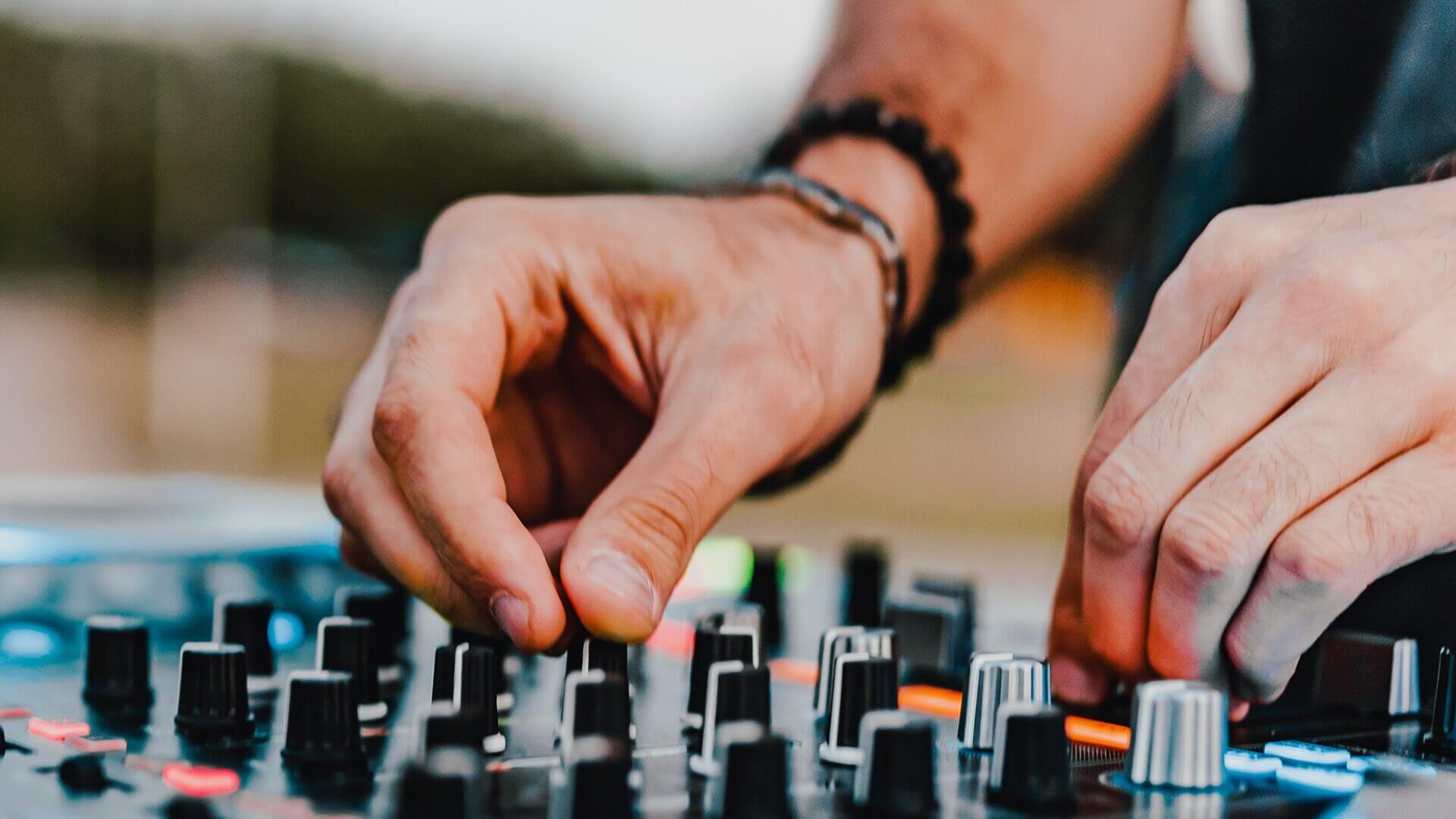Knowing how to plan a DJ mix is like mastering the art of storytelling, but instead of words, you’re mixing together beats, rhythms, and melodies. It’s not just about having a collection of tracks to play; it’s about understanding the ebb and flow of a musical journey. Whether you’re pumping up a crowd or setting the mood at a private event, the ability to plan a DJ mix effectively can set you apart from other DJs.
In this guide, I’m going to show you 6 simple steps on how to plan a DJ mix, but don’t think these steps are the only way to do it. This is merely a helping guide to get you started, and from here you will be able to find your own way of planning DJ mixes as you progress in your DJ career.
So, let’s jump into these essential steps, ensuring you not only have the right tracks lined up but also understand how to blend them together for maximum dancefloor impact. Whether you’re a seasoned pro or just starting out, this guide will enhance your mixing skills and bring your DJ performances to a whole new level.
Table of Contents
Step 1: Define Your Audience and Event Type

The first step in planning your DJ mix is to understand your audience and the specific type of event you’re playing at. This is more than just track selection; it’s about refining the energy levels and musical journey to fit the crowd and setting. The key elements to this are:
- The Audience: If you’re energising a club filled with dance enthusiasts or creating a relaxed ambiance at a private event, understanding the audience demographic is key. This knowledge will help with your setlist curation and track selection that resonate on a deeper level.
- Event Dynamics: The event type significantly influences your DJ set structure. Festivals may require upbeat, dynamic tracks, while a lounge or private event could lean towards more varied or down-tempo selections.
- Set Duration and Timing: The length and timing of your set are crucial. An extended set offers room for a gradual build-up and varied musical storytelling, while a shorter set demands a quicker, more immediate engagement with the audience.
- Research and Adaptability: Especially crucial for live performances, understanding the venue’s atmosphere and past events can be invaluable. This can involve reading the crowd and adapting your approach, ensuring your DJ mix flow aligns perfectly with the audience’s energy.
Incorporating these insights ensures your DJ mix isn’t just a playlist but a carefully planned musical journey tailored to your audience. It’s about creating a unique experience, one track at a time, and setting the stage for an unforgettable performance.
Step 2: Select Your Tracks

The tracks you choose are the backbone of your DJ mix. This step is about more than just picking songs you like; it’s about crafting a cohesive, engaging set that speaks to your audience. Here’s how to make your track selection impactful:
Harmonic Compatibility
Utilise the principles of harmonic mixing to create smooth, pleasing transitions. By mixing tracks that are in complementary keys, you enhance the musical flow and maintain a consistent vibe. Tools like key detection software can be handy, but trust your ear as well.
Balance Energy Levels
A great mix takes the listener on a journey through peaks and valleys of energy. Consider the energy level of each track and how it fits into the overall narrative. Start with lower energy tracks and gradually build up, or plan for strategic moments of intensity and relaxation.
Genre and BPM Considerations
While maintaining a consistent genre can be effective, don’t be afraid to blend different styles to keep things interesting. Also, be mindful of the BPM (Beats Per Minute) of your tracks. A drastic change in BPM can disrupt the flow, so aim for smooth transitions in tempo.
Personal Favourites and Surprise Elements
Infuse your set with your personality by including tracks that are meaningful to you. Additionally, surprise your audience with an unexpected track or a unique remix to keep them engaged and excited.
Track Length and Order
Be strategic about the length of each track in your mix. Longer tracks can establish a groove, while shorter ones can create quick shifts in energy. The order of tracks should contribute to the narrative you’re crafting, leading your audience through a seamless musical experience.
By thoughtfully selecting tracks that complement each other in key, tempo, and style, you’re laying the foundation for a mix that’s not just enjoyable but memorable. Remember, each track is a chapter in the story you’re telling, so choose wisely to make your mix stand out.
Step 3: Understand The Transitions

Transitions are where the magic happens in a DJ mix. They can make or break the flow and are crucial for maintaining the energy and engagement of your audience. Mastering transitions is both an art and a science. Here’s how to excel at it:
- Smooth Beatmatching: The foundation of a good transition is beatmatching – synchronising the beats of two tracks. This creates a seamless flow from one song to another, maintaining the rhythm and energy. Practice makes perfect, so spend time honing this skill.
- Use of Effects and EQ: Creative use of effects (like reverb, echo, or filters) and EQ adjustments can add flair to your transitions. These tools can help blend tracks together or create a dramatic change in energy. Remember, subtlety is key; overdoing effects can detract from the music.
- Anticipating the Mix Points: Plan where in the tracks you will transition. It could be during a drum break, at the end of a chorus, or during a quiet bridge. Knowing these mix points in advance helps in executing smooth transitions.
- Harmonic Transitions: For an even more polished sound, consider the key of your tracks. Transitioning between tracks in harmonically compatible keys can create a musically cohesive experience, making your mix sound more professional.
- Experiment with Different Styles: Don’t be afraid to experiment with different transition styles. Quick cuts, long blends, or tempo changes can add variety to your set. The key is to match the transition style with the mood and energy of your tracks.
Mastering transitions requires practice, patience, and a keen ear. By focusing on these elements, you can create transitions that not only sound good but also enhance the storytelling of your DJ mix.
Step 4: Structure Your DJ Mix

Imagine you’re not just creating a playlist, but painting a musical landscape. In this phase, we’re focusing on how each track contributes to the overall narrative of your mix. It’s about guiding your audience through an emotional journey, filled with peaks of high energy and valleys of calm.
Crafting the Narrative Arc
Think of your mix as a story with a beginning, middle, and end. We start with the introduction – the mellow, setting-the-scene tracks. As we progress, we build up the energy, moving towards the climax – this is where your most impactful, show-stopping tracks come into play. Finally, we gently wind down, easing our audience into a smooth, satisfying conclusion.
The Art of Balance
The key here is balance. Blend in your high-energy tracks with more subdued tunes, allowing for emotional and energetic peaks and valleys. This variation keeps the audience engaged, eagerly anticipating what comes next. It’s like a dance – knowing when to lead and when to follow the audience’s energy.
Example: Imagine dropping a high-energy track right after a chill, groovy number. The contrast can be electrifying, capturing the crowd’s attention instantly.
Flexibility and Adaptation
Remember, a DJ’s strength lies in adaptability. If you sense the crowd craving more of a certain vibe, don’t hesitate to tweak your planned structure. The ability to read and respond to the audience is what separates a good DJ from a great one.
The Technical Touch
Don’t forget the technical aspects. Smooth transitions in energy levels and BPMs are crucial. A sudden jolt in tempo can be exciting but should be used sparingly and deliberately.
Pro Tip: A moment of silence or a well-placed break can create suspense, making the entrance of the next track even more impactful.
Step 5: Personalise Your DJ Set

Personalising your DJ set is where your unique signature comes into play. It’s about infusing your mix with a distinct flavour that sets you apart from others. This step is less about technical skills and more about showcasing your personal style and musical preferences. Here’s how you can make your set distinctly yours.
Inject Your Musical Identity
Every DJ has a unique musical identity, a particular sound or style they’re drawn to. Are you a fan of classic house beats, or do you lean towards edgy techno? Perhaps you have a soft spot for funk or soul-infused tracks. Embrace these preferences. Your set should be a reflection of what you love, as your enthusiasm for these tracks will naturally transmit to your audience.
Example: If you have a love for vintage disco tracks, don’t shy away from throwing one into your mix. The surprise and your obvious enjoyment can be contagious!
Experiment with Original Remixes and Mashups
Creating your own remixes or mashups of existing tracks is a fantastic way to stand out. It demonstrates your creativity and technical skills, while also offering something completely unique to your audience.
Anecdote: I recall a DJ who blended a classic rock anthem with a modern house track. The crowd was both surprised and thrilled, as the familiar collided with the new in a delightful way.
Storytelling Through Music
Think of your set as a canvas for storytelling. You can convey moods, emotions, and even narratives through your track selection and sequencing. A well-crafted set can take your audience on a journey, from upbeat, danceable tracks to more introspective, melodic pieces, and back again.
Engage with Your Audience
Personalization isn’t just about what you play, but also how you interact with your audience. Read the crowd, engage with them, maybe even take requests if it fits your style. Building a rapport with your audience makes your set feel more personal and connected.
Stay True to Yourself
While it’s important to read the room and adapt, always stay true to your artistic vision. Your authenticity as a DJ is your strongest asset. Trust in your taste and your ability to curate a unique experience.
Step 6: Prepare and Practice Your DJ Mix

The final step in planning a DJ mix is arguably the most crucial: preparation and practice. This stage is where you refine your mix, work out any kinks, and ensure you’re ready to deliver a seamless performance. Here’s how to approach this vital phase:
- Comprehensive Preparation: Go beyond track familiarity. Understand each song’s nuances, how they harmonise together, and their energy contributions to your set.
- Set Visualisation: Mentally walk through your mix, focusing on track transitions and audience reaction. This enhances memorization and anticipatory skills.
- Dedicated Practice: Regularly practise your set, focusing on skill enhancement through experimenting with transitions, effects, and new techniques.
- Critical Self-Review: Record and critique your practice sessions to gain an audience perspective, and be open to making necessary adjustments for improvement.
- Seek and Apply Feedback: Actively seek input from peers or mentors and be receptive to constructive criticism for set refinement.
- Realistic Practice Environment: Whenever possible, practice under conditions that replicate your live performance setup.
- Organisational Efficiency: Maintain a well-organised music library for quick and efficient track selection during performances.
- Backup Strategies: Always have a plan B, including backup equipment and alternative track options, to handle unexpected technical issues.
FAQs
How Many Songs in a 1 Hour DJ Set?
The number of songs in a 1-hour DJ set can vary significantly depending on factors like the genre of music, the length of the tracks, and your mixing style. For instance, genres like house or techno, which typically have longer tracks, might see around 10-15 songs in an hour. In contrast, genres with shorter songs, like pop or hip-hop, could have 20-30 songs or more. As a guideline, planning for 15-20 songs is a good start, but my advice would be to focus on the flow and feel of the set, not just the number of tracks.
Do I Need To Plan My DJ Sets?
Planning your DJ sets is generally advisable, especially for specific events or venues. A planned set allows you to curate a journey, ensuring that the energy flow, track selection, and transitions are thoughtfully arranged. However, the degree of planning can vary.
Can I Just Improvise my DJ Mix Instead?
Improvisation is an essential skill for a DJ, and many experienced DJs thrive on reading the crowd and selecting tracks on the fly. However, pure improvisation without any preparation might be challenging for beginners. It’s beneficial to have a rough plan or a pool of tracks you’re familiar with and comfortable mixing.




